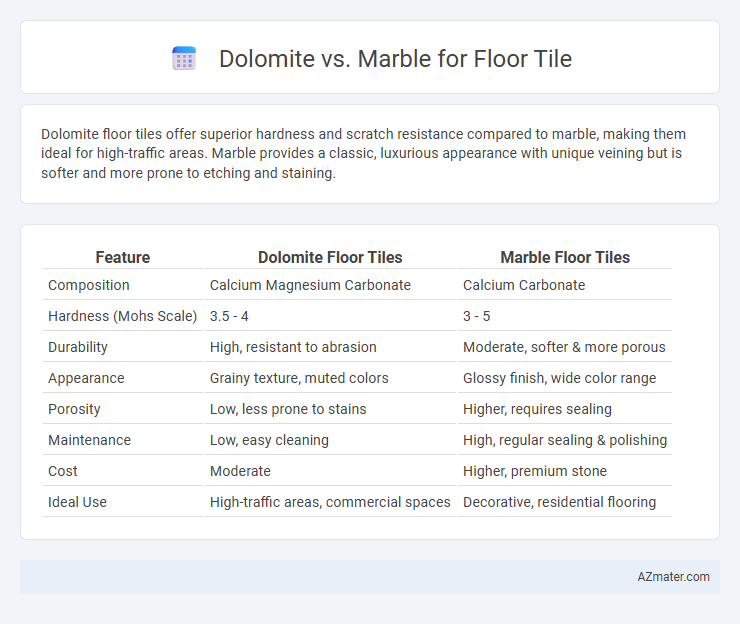Dolomite floor tiles offer superior hardness and scratch resistance compared to marble, making them ideal for high-traffic areas. Marble provides a classic, luxurious appearance with unique veining but is softer and more prone to etching and staining.
Table of Comparison
| Feature | Dolomite Floor Tiles | Marble Floor Tiles |
|---|---|---|
| Composition | Calcium Magnesium Carbonate | Calcium Carbonate |
| Hardness (Mohs Scale) | 3.5 - 4 | 3 - 5 |
| Durability | High, resistant to abrasion | Moderate, softer & more porous |
| Appearance | Grainy texture, muted colors | Glossy finish, wide color range |
| Porosity | Low, less prone to stains | Higher, requires sealing |
| Maintenance | Low, easy cleaning | High, regular sealing & polishing |
| Cost | Moderate | Higher, premium stone |
| Ideal Use | High-traffic areas, commercial spaces | Decorative, residential flooring |
Introduction to Dolomite and Marble Floor Tiles
Dolomite floor tiles are known for their durability and natural resistance to scratches and stains, making them a practical choice for high-traffic areas. Marble floor tiles offer a luxurious, elegant appearance with unique veining patterns, enhancing the aesthetic appeal of interiors. Both materials provide distinct textures and finishes, with dolomite being slightly harder and more dense compared to the softer, more porous marble.
Composition and Formation of Dolomite vs Marble
Dolomite floor tiles originate from dolostone, primarily composed of the mineral dolomite (calcium magnesium carbonate), formed through the alteration of limestone by magnesium-rich fluids in sedimentary environments. Marble tiles consist mainly of recrystallized calcite or dolomite crystals, formed through the metamorphism of limestone under intense heat and pressure, resulting in a denser, more crystalline structure. The key difference lies in dolomite's sedimentary origin with a higher magnesium content, while marble's metamorphic formation leads to distinct aesthetic veining and increased hardness.
Appearance and Aesthetic Differences
Dolomite floor tiles exhibit a softer, more muted color palette with subtle veining patterns, offering a natural, understated elegance suitable for minimalist and contemporary interiors. Marble tiles, known for their dramatic veining and wide range of vibrant colors, create a luxurious and bold statement, often favored in classic or high-end designs. The contrasting textures of dolomite's matte finish versus marble's glossy sheen add distinct visual appeal, influencing the overall ambiance and style of the space.
Durability and Hardness Comparison
Dolomite floor tiles offer superior hardness compared to marble, with a Mohs hardness rating of approximately 3.5 to 4.5, making them more resistant to scratches and wear. Marble, rated around 3 to 4 on the Mohs scale, is softer and more prone to etching and surface damage in high-traffic areas. Both materials provide aesthetic appeal, but dolomite's enhanced durability makes it a better choice for flooring in commercial or heavily used spaces.
Maintenance and Cleaning Requirements
Dolomite floor tiles require less maintenance compared to marble, as they are more resistant to scratches and stains, reducing the need for frequent sealing. Marble tiles demand regular sealing and gentle cleaning with pH-neutral products to prevent etching and discoloration caused by acidic substances. Both materials benefit from prompt spill cleanup, but dolomite's durability makes it a more practical choice for high-traffic areas with minimal upkeep.
Stain and Scratch Resistance
Dolomite floor tiles exhibit higher stain resistance compared to marble due to their denser composition and lower porosity, making them less prone to absorbing liquids and discoloration. In terms of scratch resistance, dolomite also outperforms marble with a harder surface that better withstands abrasion and daily wear. Choosing dolomite tiles ensures more durable flooring that maintains its aesthetic appeal longer in high-traffic or spill-prone areas.
Pricing and Cost Analysis
Dolomite floor tiles generally cost 20-30% less than marble tiles, making them a budget-friendly option for large-scale flooring projects. Marble flooring prices vary between $10 to $30 per square foot, influenced by the source country and veining complexity, whereas dolomite typically ranges from $7 to $20 per square foot. Maintenance costs for marble tend to be higher due to its porous nature requiring sealing and specialized cleaning products, while dolomite offers greater durability with lower upkeep expenses over time.
Installation Process and Considerations
Dolomite floor tiles require precise sealing before installation to prevent moisture absorption and are typically heavier, necessitating a sturdier subfloor and specialized adhesives. Marble tiles demand careful handling due to their porous nature and susceptibility to etching, requiring acid-resistant sealants and slip-resistant backing for safe, durable placement. Both materials benefit from professional installation to address cutting intricacies and to ensure long-term durability and aesthetic appeal in flooring projects.
Environmental Impact and Sustainability
Dolomite floor tiles have a lower environmental impact than marble due to their more abundant availability and less energy-intensive extraction processes. Marble mining often results in significant landscape disruption and higher carbon emissions from quarrying and transportation. Dolomite's durability and resistance to weathering contribute to a longer lifespan, enhancing its sustainability as a flooring material.
Best Applications for Dolomite and Marble Tiles
Dolomite tiles are ideal for high-traffic areas and outdoor spaces due to their superior durability and resistance to weathering, making them perfect for patios, kitchens, and commercial flooring. Marble tiles excel in low-traffic, decorative applications such as bathrooms, living rooms, and luxury interiors where their elegant appearance and unique veining can be showcased. Both materials provide distinct aesthetic and functional benefits, with dolomite favored for strength and marble for its classic beauty.

Infographic: Dolomite vs Marble for Floor Tile
 azmater.com
azmater.com